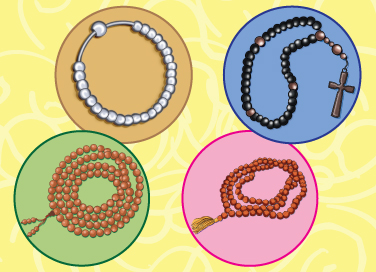Japamala – The Spiritual String of Beads
- March 1, 2021


Japamala – The Spiritual String of Beads
- March 1, 2021
By Srinidhi Murthy
A japamala, referred to as a rosary in English, is a string of beads used to keep the mind focused and clear while reciting the divine name. The word comes from two separate words; japa meaning recitation (of the divine name) and mala meaning garland. A japamala is used in Hinduism, Jainism, Sikhism, Buddhism and many other traditions for the spiritual practice referred to as japa. The use of a japamala while praying is a widespread practice since ancient times and it is not known exactly when this started.
Japamalas are made using a variety of materials depending on the tenets of the faith of the practitioner, the kind of prayers and also the geographical availability of materials.
To receive more such stories in your Inbox & WhatsApp, Please share your Email and Mobile number.
Shaivas, the devotees of Shiva use the seeds of the Rudraksha tree and Vaishanavas, the devotees of Vishnu use the beads from the wood of the Tulsi plant in their japamalas. These plants are especially dear to the deities they revere. Buddhists prefer seeds or wood from various species of the Bodhi Tree as it represents the place of Siddhartha Gautham’s enlightenment.

In Hindu mythology, 108 is an auspicious number, so you are most likely to find that many beads in the mala used by the devotees. Saraswati, the goddess of wisdom, Brahma, the god of creation and Dattatreya, the god of yoga are all seen with a japamala in their hands representing the power of meditation and spirituality.
Japamala is a conventional meditation and prayer tool in Buddhism, and it is especially common among Tibetan Buddhists. Similar to the practice in Hinduism, the japamala contains 108 beads and that represents the mortal desires of humans. The beads are commonly used to count the recitation of mantras and for meditative breathing. The prayer beads maybe painted in specific colours and can be made of bodhi wood, sandalwood, metal, shells, seeds, or other materials to support the main focus of the meditation.
In Christianity, the practice of using the rosary or chaplet for prayer was adopted somewhere around the third century by the Eastern Christian monks. ‘Rosary’ is derived from the Latin word rosarium, which means ‘a crown of flowers’. The beads of the chaplet may be arranged in five decades (sets of 10), each decade separated from the subsequent by a bigger bead. The 2 ends of the chaplet are joined by a little string holding a crucifix, two large beads and three small beads. In Roman Catholicism, the rosary is a well-liked method of public and personal prayer. The prayers may be dedicated to the Virgin Mary, Jesus Christ or a specific saint like Saint Michael.
In Islam, the rosary consists of three groups of beads whose total is a hundred. Each bead represents one of the names of God and helps to count these names. It is also carried by pilgrims.
Sikhs also use the japamala for prayers. The devout use it to repeat the Gur Mantar or Mool Mantar, which are specific chants. They have a selected number of small beads and one large bead to mark the completion of one count of the rosary. Again, the number hundred and eight is popular as it is considered to represent infinity. There is no ritual attached to the number of beads on any mala in Sikhism. It is only meant to encourage remembrance of the divine through the practice of prayer and meditation.
The japamala cuts across various faiths and brings together all spiritual practitioners in their journey to that one ultimate truth that they all are seeking.
To receive more such stories in your Inbox & WhatsApp, Please share your Email and Mobile number.

Comic of The Month
The Naval Journey of India Book I
This book is the first of a three-book series that takes a deep and detailed look at India's Naval History and a deep insight into the lives of our men and women in white. But any series on the Indian Navy has to start at the very beginning - exploring India's celebrated maritime history. Join our little hero, Bharat, and his grandfather, Commodore Sagar, as they sail into the deep blue waters of time. Book I of The Naval Journey of India takes a sweeping look at India's maritime endeavours, how the seas impacted us over millennia and how the oceans made us who we are.